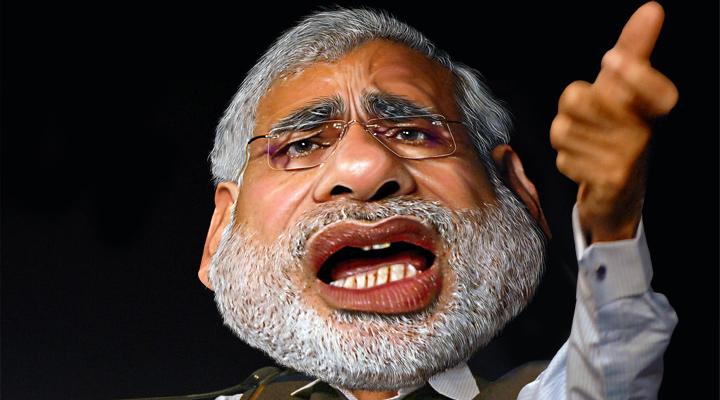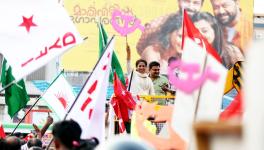The Economy Under Modi

Image Courtesy: Flickr
The Modi government’s record in tacitly supporting the actions of a bunch of vigilante thugs who have been terrorizing the country, especially the Muslims and the dalits, in the guise of gaurakshaks, or opponents of love jihad, or “nationalists”, has been so outrageous that it has grabbed all the critical attention. In the process the government’s abysmal failures in other spheres has gone virtually unnoticed. One such sphere is the economy whose dismal state is sought to be camouflaged by hyped-up figures of growth of the Gross Domestic Product (GDP).
In fact, GDP figures these days engage one like an Edmund Crispin detective novel: in Crispin’s novels one is forever occupied trying to identify the murderer from the clues the author gives; likewise with GDP data these days one gets primarily occupied trying to discover how truth has been done away with by the estimates. It is their “post-truth” character rather than the data themselves which absorbs one.
But even official data cannot hide certain things about the Modi years, and in what follows I rely exclusively on official data. The gross domestic product at factor cost originating in agriculture is the source of the incomes of all those engaged in this sector: agricultural labourers; peasants of different categories; capitalist farmers; and landlords, both feudal and capitalist. True, some of them, notably the landlords and capitalist farmers, may have incomes from other, non-agricultural sources, such as trade, cinema halls, or transport business; but their numbers being relatively small, as long as their share in the GDP originating in agriculture does not fall, we can safely infer that an observed fall in per capita GDP originating agriculture implies a fall in the per capita income of the agriculture-dependent population.
Income of course should mean net income, i.e. gross income minus a deduction for the depreciation of fixed capital, but the ratio between gross and net incomes does not change much over short periods; so, taking per capita GDP at factor cost for examining trends in per capita income of the agriculture-dependent population seems legitimate.
Now, to see what has been happening during the three Modi years, let us make a point-to-point comparison of the pre-Modi base year 2013-14 with the last of these three years, 2016-17. This way we also avoid the two middle years, 2014-15 and 2015-16, which were poor harvest years because of successive droughts, and whose inclusion would have exposed us to the charge that we are unfairly blaming the Modi government for a natural phenomenon like drought.
Since over such a short period as three years, there is unlikely to have been much shift in the sectoral composition of the work-force, and hence of the population dependent upon it, we can quite legitimately take the rate of growth of the agriculture-dependent population as being equal to the rate of growth of the overall population of the country.
Let us now come to the calculations. From official data it can be seen on this basis that the per capita GDP at factor cost in current prices increased by 16 percent between 2013-14 and 2016-17, which everybody acknowledges to have been a very good crop year (so that none can accuse us of unfairness). But exactly over the same period the Consumer Price Index for Rural India increased by 16.8 percent. The per capita nominal income of the agriculture-dependent population in other words increased less than the price index, which means that there was a marginal decline in the per capita real income of the agriculture-dependent population over these three years.
Agriculture accounts for roughly half of the total work-force of the country. Assuming identical work-force to population ratio in agriculture as elsewhere, what this means is that roughly half of the country’s population witnessed no increase whatsoever, indeed on the contrary a marginal decline, in its real per capita income over the three Modi years. This is a fact of great significance.
The agrarian crisis of course pre-dates Modi, and has to do with the withdrawal of State support from peasant agriculture, and the exposure of this sector to the operations of agribusiness and domestic and foreign monopolists, as part of neo-liberal economic policy. The point however is that the Modi government has been fully complicit in this squeeze on the agriculture-dependent population by neo-liberalism. Indeed, as I suggest below, it has been unthinkingly neo-liberal, and for that reason ultra-neo-liberal, to a degree far surpassing anything we have seen earlier.
In the non-agricultural sector in general, output and employment (employment here must exclude “disguised unemployment”), are demand-determined. Now, a part of the demand, what one may call the “endogenous” component of demand, comes from the output of this sector itself: larger output means more incomes generated in this sector and hence a larger demand out of these incomes for the sector’s own products. To see why the output of this sector is what it is, we have to focus, therefore, on the “exogenous” or the “autonomous” element of the demand for this sector’s product, the element not dependent upon its own income.
One important exogenous element of the demand for non-agricultural goods and services, comes obviously from agricultural incomes. But these, we have seen, have been stagnant in per capita terms over the three Modi years, which means that this source of demand has not grown over this period.Since investment tends to respond to the change in the size of the market and hence to the size of output, it cannot be taken as an exogenous element at all. This leaves us with only two other elements which can be taken as exogenous; one of these is net exports and the other is Government expenditure. (Boost to autonomous consumption through asset-price bubbles, which leave asset-holders feeling wealthy, and hence consuming more, play a relatively small role in the Indian economy).
The demand arising from net exports (i.e. exports minus imports) has been fairly sluggish over this period, because of the crisis in the world economy and also the protectionism increasingly adopted by the U.S. Such protectionism, by discouraging U.S. firms from “outsourcing” service sector activities, hurts the exports of services from countries like India. True, the lower oil prices in the world economy should have had the effect of boosting domestic demand, if these lower prices had been passed on to the consumers. But this did not happen; on the contrary the government just took advantage of the lower world oil prices to garner larger revenues through excise duty.
With such larger revenues, or even without them, if government expenditure had increased significantly, then we could have had a genuine exogenous boost to demand, and hence an increase in the output and employment in the non-agricultural sector. But here we come to the real crux of the matter. The total nominal expenditure by the central government increased by 6.7 percent in 2014-15, by 7.6 percent in 2015-16, and by 12.5 percent in 2016-17 (RE), when the Pay Commission’s recommendations had to be implemented. The increase in total expenditure proposed in the 2017-18 budget is again only about 6 percent. Since in each one of these years, the nominal GDP growth has exceeded 11 percent, what this suggests is that central government expenditure as a proportion of nominal GDP has been falling; even the Pay Commission-driven increase in 2016-17 scarcely contributes to an increase in this proportion.
In a situation where per capita agricultural income has not been increasing and the stimulus from net exports has been waning, the need of the hour was an increase in the stimulus from government expenditure. But we find instead that government expenditure as a proportion of GDP has been declining over this period. The government in other word has been more keen to keep finance capital happy by restraining expenditure, than to sustain output and employment growth in the economy. And while this fact may not be manifest in the GDP estimates (because of the flawed methodology adopted of late for estimating GDP), it is certainly manifest in the employment figures. The number of new jobs created in the organized sector of the economy, which used to be about 8-9 lakhs per year in 2010 and 2011 and which was nonetheless lower than the number of new persons seeking work, has now fallen to less than 2 lakhs per year, which expresses the seriousness of the crisis.
The government’s fiscal conservatism arises from an unthinking adherence to the neo-liberal prescription of “fiscal responsibility”. The effects of such unthinking adherence have been compounded by its unthinking “macho” measures like the demonetization of currency notes.All these measures reflect the government’s generally unthinking character. The country’s economy has scarcely been in the hands of more unthinking persons.
Disclaimer: The views expressed here are the author's personal views, and do not necessarily represent the views of Newsclick.
Get the latest reports & analysis with people's perspective on Protests, movements & deep analytical videos, discussions of the current affairs in your Telegram app. Subscribe to NewsClick's Telegram channel & get Real-Time updates on stories, as they get published on our website.
























